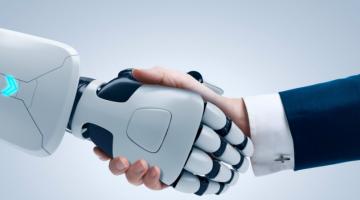The EGN Digital Dictionary for Executives and (other) Tech-novices

You know the feeling. You’re standing there and nodding like you have understood everything the IT-savvy guy has just said. But internally you are filled with doubt. What on Earth was he talking about? You start to fear you are missing out on something important.
If this sounds like you then don’t worry – instead, remember this:
Unless they are an IT-professional or have spent most of their youth in a hackerspace, everybody else in the room is also filled with the same kind of fear as you.
Doesn’t it seem like every day a new technological expression, digital system or must-have gadget pops onto the scene? There is now so much tech-talk flying around that, to misuse the cliché – it feels like a (digital) jungle out there.
But never fear, because EGN brings you the Digital Dictionary for Dummies, which you can take a look at the next time you hear a geeky term that you don’t quite understand.
First of all – some common terms:
Ad blocking – this means using a piece of software called an ad blocker that prevents adverts from appearing on your smartphone, tablet or computer. These are very useful, if you don’t like looking at a thousand and one pop-up ads, but web firms don’t like them as they deprive them of revenue.
Back-end and front-end – are terms used to describe the activity done by or close to the user. Front-end is the user interface activity, while back-end refers to the “behind the scenes” activities at the operator level.
Blockchain technology – this is a system designed to make it difficult/impossible to change former transactions. Think of it as a continuous growing list of connected blocks of data, which are connected using cryptography and spread across the Internet. Each block typically consists of an encrypted reference to a previous block, a time stamp and a number of transactions. The most well known example of a system using blockchain is Bitcoin.
Bitcoin – is a digital cryptocurrency, which can be used both as a payment and a storage of monetary value. Bitcoin is created — or ‘mined’ — using powerful computers running complex algorithms. It is a decentralised system and uses blockchain technology that makes it difficult to manipulate or destroy, even by national governments. Bitcoin is traded on various global exchanges and its price is determined by supply and demand.
Cookies – No, not the ones you eat! A cookie is a small piece of data employed by websites and stored on your smartphone, tablet or computer. There are four types of cookie:
- Function cookies. These make the website function in relation to its purpose e.g. web shopping. In this example, the cookie will remember what you have put in the basket.
- Statistics cookies. These collect data on behaviour when you visit a website, allowing the company to optimise the design and make the website more user-friendly.
- Personalised tracking cookies. These follow you around the website and read your digital trail in order to target the content at you and your specific preferences.
- Marketing cookies. As you might expect, these are cookies that collect information on your browsing habits so that campaigns and advertisements can be targeted directly at you in future.
CPU – the Central Processing Unit. If it’s so small that it can fit in a chip, it is called a microprocessor. The CPU is the central calculating unit in a computer, and the reason why it can basically be described as its brain.
Dark Web / Deep Web – beneath the tranquil surface of the Internet that we know, you can find a world of hidden websites which operate under conditions of full anonymity. This is the place where terrorists, paedophiles, drug dealers and other criminals operate.
The Onion Router (TOR) – also called the Tor Project — is a piece of free software that allows “onion routing”, which is a technique to anonymously communicate through a data network. It is legal to use if you wish to work on the Internet without leaving a trail.
Bonus info: the Tor Project is financed by a number of Western governments, including the USA.
DDoS Attack – a method of overloading a website with traffic in order to prevent it from functioning. If you’d like an analogy, imagine a child’s birthday party that’s set up for a small group of youngsters to play party games and eat cake. But the invitation is spread around on the Internet and instead of a group of innocent eight-year-olds, you get 900 drunken teenagers turning up and causing mayhem. A DDoS attack is a digital version of this.
Devices, Gadgets – a device is something useful that might include your iPhone, laptop or digital camera. Gadgets, on the other hand, often are very smart, but not particular necessary, and sometimes feature very over-the-top technology with questionable utility. A gadget, for instance, might include the fork that can track whether you chew the food enough, or the toilet roll holder that tells you when you are about to run out.
Doxing (or Doxxing or Docxing) – is a sinister hacking-related phenomenon whereby private information is obtained on an individual or company and broadcast using the Internet. Commonly, a victim of doxing will find their personal details displayed on social media by an anonymous attacker.
Encryption – this is a form of encoding that protects your data and prevents others from reading it.
Hacking – the deliberate breaking into of a computer system or website to cause mischief or steal data.
HTML (Hyper Text Markup Language) – is the ‘language’ that dictates how text and images appear on a screen. In HTML, the symbols < > / are used to mark the open and close of specific commands. Common tags might specify whether text should be in Bold or Italic, where to place paragraph spacing, and the size of a picture.
Phishing – is an unlawful attempt to obtain confidential information such as credit card details, passwords etc. Often these take the form of realistic-looking emails from reputable institutions, such as banks or insurance companies, asking you to provide information. The phishers then take your information and use it to defraud you.
Spoofing – is what occurs when you click on a link that looks like a trusted source, but it turns out to be a phishing attack. Visiting some spoof website can cause your computer or device to be infected with a virus.
Trolls – are Internet users who are to some extent anonymous, and enjoy harassing others or participating in a debate only with a goal of destroying the discussion or peoples’ happy mood. The natural habitat of a troll is of course online tabloid news sites e.g. The Sun.
UX – a shortening for User eXperience, i.e. of visiting a company website or using an app. CX – is closely related to UX but refers to the Customer eXperience. It covers the full customer experience across various points in the sales and marketing journey.
Zero-day / Day Zero – a weakness in a computer system which is hard to detect and can be used by hackers, if it’s not stopped in time.
And now, the trends:
Artificial Intelligence — or, machine learning, is where computers are able to learn for themselves, rather than just follow a set commands issued by humans. They do this by continuously collecting data from sensors, applying an action and gathering more data from the real world to assess the results of that action.
Augmented reality – is where the user sees computer-generated pictures, sound and other data overlaying the actual physical reality. Typically, one or more cameras feed into a device, which then outputs a video display overlaid with an extra level of digitised effects.
One example is Pokémon Go! But the technology can of course be used for much more than caching Pikachu. Ikea, for example, uses an augmented reality app to check whether there is space for a couch in your living room.
Big data – is a term within computer science covering the collection, storage, analysis and interpretation of huge amounts of data of different types (such as transaction data, incoming sensor data, video surveillance, Twitter feeds etc.)
If it’s used in the right way, it can change the decision-making process in a company.
Google Glass – this is the name given to a pair of high-tech wearable spectacles developed by Google. You simply put on your Google Glass and voilà!, you have an augmented reality computer screen in front of your eyes. You can talk to, take pictures, shoot videos, take notes and surf on the Internet using this.
Google Glass is especially smart if you need to collect data and at the same time work with your hands free – such as a fisherman who needs to report the day’s catch but doesn’t want to waste his evening typing it up from handwritten notes. In that way, he can register it while he is working.
Bonus info: Google Glass was launched in 2013, but with little success. People were afraid that the users (primarily super-geeks), walked around and filmed them, which gave rise to the term “Glasshole”.
Internet of Things (IoT) – this refers to physical objects with built-in technology that are connected via the Internet. For instance, cars, buildings and gadgets that contain CPUs, software, electronic sensors and Internet connection, might all be considered part of the IoT if they exist on a network and can talk to one another.
The potential of the IoT is therefore huge, if one thinks about it.
Bonus info: In 2016, there were seven billion IoT-units connected to the Internet. This is a number equal to the entire population of the world, and it is growing all the time.
Cognitive IoT-computing – is the IoT with added artificial intelligence. Cognitive systems can use data to learn and apply reasoning to improve performance in real time
An example might be a computerised controller that detects a heavy vibration coming from a factory machine. It looks the problem up in the (digital) manuals and repair-logs, and then tells the human operator what to do to fix it and prevent the machine from breaking down.
Cryptocurrencies – these are digital currencies that can be used to trade goods and services. Unlike national currencies, cryptocurrencies are not issued or controlled by central banks but are instead created by ‘miners’ running algorithms on computers. They have enjoyed an explosion of popularity recently, the most famous example being Bitcoin.
Sensors – you can find these in almost every device or gadget. One example is sensors installed in trashcans and trees to notify just the right person when a trashcan is full or when the tree needs watering.
The benefit of using sensors here is that that workers don’t have to drive around to every tree ensuring that they are thriving – or check every trashcan to ensure they are emptied.
Virtual reality – is a tech phenomenon that is used to create a very lifelike virtual world in 3D using a computer simulation. Aside from all the exciting (and sometimes naughty) ways in which VR can be used, the technology can be employed to train surgeons, meaning real humans don’t have to be guinea pigs.
Thanks to Anders Quitzau of IBM, Alexander Richter of I4L/ITU, Washington Post’s Sideways Dictionary, The Danish Business Authority and the Internet (no, not the dark one).
If you have anything you think should be included in the dictionary, you are welcome to send us an email at: medier@egn.dk



